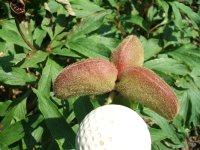 Paeonia mollis
Paeonia mollis, a "pseudospecies". It is apparently no longer to be found in the wild, but has perpetuated in gardens, coming true from seed. A smaller plant, only knee-high, with soft-textured attractive leafs. The seeds are noticeably

different from all other peony species.

And here the first of my various
Paeonia officinalis plants to open,
ssp banatica.

And
Paeonia triternata with it's lovely 2-tone pink flowers and the excellent undulate blue-green waxy foliage. Neither flower nor foliage are apparently consistently unique across variablity of the species, so apparently the population my

seeds were collected from is a more worthwhile form.
 Paeonia mollis, a "pseudospecies". It is apparently no longer to be found in the wild, but has perpetuated in gardens, coming true from seed. A smaller plant, only knee-high, with soft-textured attractive leafs. The seeds are noticeably
Paeonia mollis, a "pseudospecies". It is apparently no longer to be found in the wild, but has perpetuated in gardens, coming true from seed. A smaller plant, only knee-high, with soft-textured attractive leafs. The seeds are noticeably  different from all other peony species.
different from all other peony species. And here the first of my various Paeonia officinalis plants to open, ssp banatica.
And here the first of my various Paeonia officinalis plants to open, ssp banatica. And Paeonia triternata with it's lovely 2-tone pink flowers and the excellent undulate blue-green waxy foliage. Neither flower nor foliage are apparently consistently unique across variablity of the species, so apparently the population my
And Paeonia triternata with it's lovely 2-tone pink flowers and the excellent undulate blue-green waxy foliage. Neither flower nor foliage are apparently consistently unique across variablity of the species, so apparently the population my  seeds were collected from is a more worthwhile form.
seeds were collected from is a more worthwhile form.











